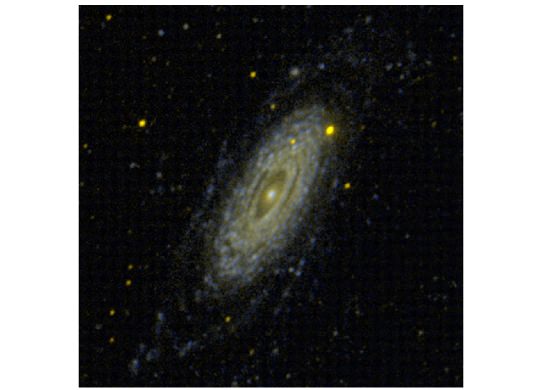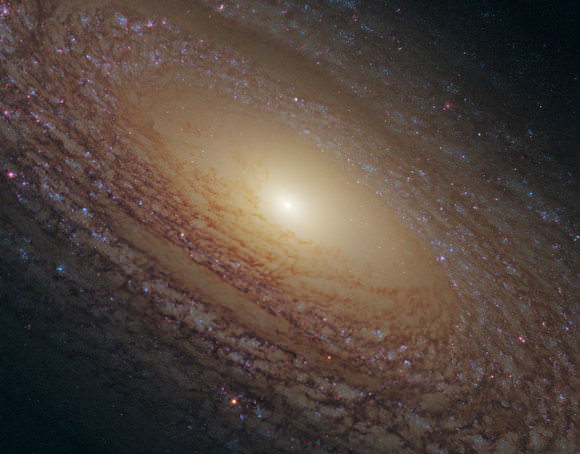[/caption]
The Flocculent Spiral NGC 2841, shown above, is known for its profusion of young, blue stars. And yet, until recently, astronomers haven’t been able to use those stars as windows into the still-mysterious phenomenon of star formation.
Hubble’s most recent wide-field camera upgrade is changing that.
The new Wide Field Camera 3 (WFC3) was installed on Hubble in May 2009 during Servicing Mission 4, and replaces the Wide Field and Planetary Camera 2. The new camera is optimized to observe in the infrared and ultraviolet wavelengths emitted by newborn stars, shown by the bright blue clumps in the lead image. Thus, it can peer behind the veil of dust that would otherwise hide those stars from view.
The image shows a lot of hot, young stars in the disc of NGC 2841, but in reality there are just a few sites of current star formation where hydrogen gas is collapsing into new stars. It is likely that these fiery youngsters destroyed the star-forming regions in which they were formed.

NGC 2841 is about 46 million light years away in the constellation Ursa Major. It’s part of a common group of galaxies called flocculent spirals; flocculent means fluffy or wooly-looking. Rather than boasting well-defined spiral arms, these galaxies display patchy stellar distribution.
Star formation is one of the most important processes shaping the Universe; it plays a pivotal role in the evolution of galaxies and it is also in the earliest stages of star formation that planetary systems first appear. Yet there is still much that astronomers don’t understand, such as how the properties of stellar nurseries vary according to the composition and density of the gas present, and what triggers star formation in the first place. The driving force behind star formation is particularly unclear for flocculent spirals.
An international team of astronomers is using Hubble’s WFC3 to study a sample of nearby, but wildly differing, locations where stars are forming. The observational targets include both star clusters and galaxies, and star formation rates range from the baby-booming starburst galaxy Messier 82 to the much more sedate star producer NGC 2841.
Source: Eurekalert. See also this NASA description and image of flocculent spiral NGC 4414.
Detailed credit information for the lead image: NASA, ESA and the Hubble Heritage (STScI/AURA)-ESA/Hubble Collaboration Acknowledgment: M. Crockett and S. Kaviraj (Oxford University, UK), R. O’Connell (University of Virginia), B. Whitmore (STScI) and the WFC3 Scientific Oversight Committee.


In addition to the HubbleSite this image of NGC 2841 is also included in the Hubble Heritage Project, which includes the four monochrome WFC3 images used to create this fantastic view: http://heritage.stsci.edu/2011/06/original.html
The hot star-forming regions of NGC 2841 show up best on the F336W (U-band) and F685W (H-a + [NII]) narrowband images.
It should be rather easy to produce a custom low-res color version of this galaxy using Photoshop & the like to combine the four JPEG images provided (note: click on the individual pix for the full-field WFC3 images.)
9 22 02.6, +50° 58? 35?
I don’t mind you guys not posting the co-ordinates because I like looking them up! BUT the ‘perfect blog’ would have that and maybe even a red light gridded sky map of the area?
Thanks Aqua. Saw your comment on the other post too. Will do!
The active nucleus (in this case a LINER) sticks out like a sore thumb too… Great shot.